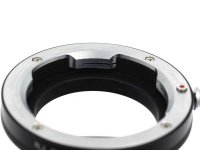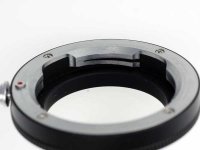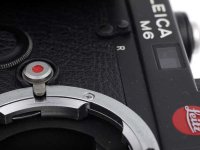I'll take a shot at this....
Mounts need to provide a guide/stop function, providing proper radial positioning of the lens. DOF guide center/infinity focus mark generally sits top dead-center at 12 o'clock, etc. This is easy, an inexpensive adapter has to be pretty sloppy to get this wrong.
The mount also needs to provide tension to seat the lens flange firmly against the body lens mount. This is more difficult, and this is the problem you're having with your adapter. Expensive adapters generally do a better job than cheaper ones.
The mount/adapter needs a mechanism to push against the top of the lens bayonet lugs to hold the lens tightly against the lens mount. Leica M bodies basically use a flat leaf spring to provide this tension, and the spring naturally adapts for varying lens flange thickness. This is an elegant, precise, reliable, repeatable and expensive way to do the job.
Inexpensive adapters have no springs, the tension is provided by a split block of metal. The bottom half of the block pushes against the top of the lens flange. The split is designed to allow the bottom half to flex and act as a spring. If the block bottom is slightly undersized, or if the lens flanges are slightly thinner, the block provides less tension, and there is play in the mount.
You can gently bend the block's bottom half lower, increasing the tension against the lens flange lug. Your tight lens will mount tighter, the loose lenses should wiggle less. You should bend gently to avoid fatiguing the metal connecting the two halves.
I'm not sure if the higher-end adapters use springs or not. I think I remember looking at a Novoflex and it didn't, I don't remember seeing the inside of a Cosina adapter closeup. None of the Novoflex adapters I've used had the play and variability I've found in cheaper adapters. For 5x-8x the cost, that's what I expect at both ends of the spectrum. I expect Novoflex adapters to be rock-solid and very tolerant of lens flange thickness variation. I'm not surprised when $30-$60 adapters are not. You get what you pay for.
Is your RJ adapter not to spec, or are your loose lenses out of Leica spec and beyond what the RJ adapter is designed to handle? I never bothered to find out. For what I paid for mine, bending a small piece of metal was preferable to returning it to China and waiting for a replacement.
I've never figured out how to embed pix in a message. I attached a few pix to illustrate the difference, but attached pix have to be tiny? One shows an M6 mount, with the spring visible. The other two show my RJ adapter, with a short block barely bent, and with a longer block bent further downward. Look at the difference in the gap between the block halves. If someone can teach me the magic to embed without linking to a url, I can embed bigger pix.




